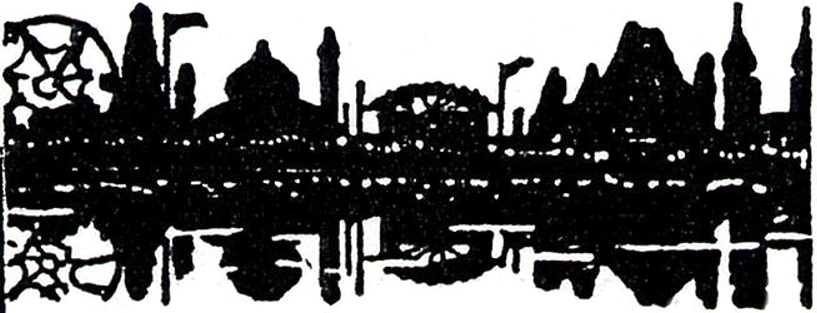

 |
||
 |
||
| [Portland History] [Site Map] [Amusement Parks] [Early Portland] [Street Scenes] [Department Stores] [Streetcars] [Railroads] [Mt Hood] [Oregon Coast] [Post Card History] [Portland Hotels] [Portland Neighborhoods] [Getaways] [Contact Us] |
|
Early Portland |
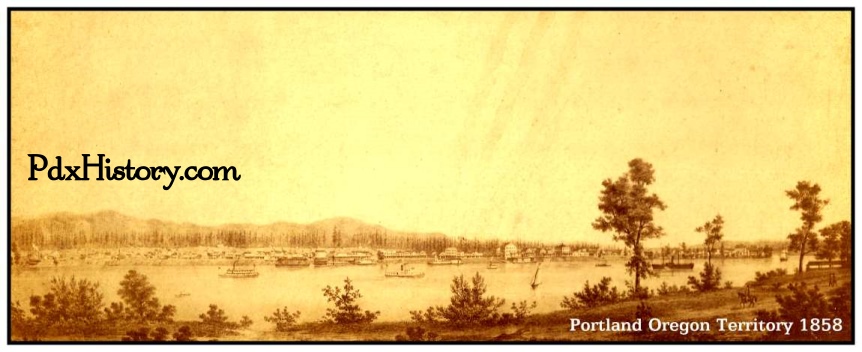 |
|
It is believed that settlement of North America and the Pacific Northwest began several thousand years ago when indigenous people from Asia made their way to the American Continent. Here in the Northwest, they discovered the mild climate and economically rich forests, prairies, wetlands and rivers. They also discovered an abundance of mammals, waterfowl, fish and plant life that developed and grew over thousands of years. By the time Europeans made contact with these inhabitants in the late eighteenth and early nineteenth centuries, the area we now call Portland was one of the most densely populated of the North American Pacific Coast. Most of the Portland Basin was inhabited by Upper Chinookan speakers, including the Clackamas and Multnomah peoples. The area known as Washington County was inhabited by Kalapuyan-speaking Tualatins and Salish-speaking groups clustered near St. Helens. The first to document the area’s native inhabitants in any detail were explorers Meriwether Lewis and William Clark, who in 1805 and 1806 noted several large Chinookan villages and smaller encampments on Wapata (Sauvie) Island (northwest of present-day Portland) and along both sides of the Columbia River in and near present-day East Portland. Lewis and Clark traded with several groups and made note of their impressive plank houses. In ther journals, Lewis and Clark described various aspects of their language, appearance, customs and material culture. |
|
|
|
Sacagawea journeyed with Lewis and Clark as their guide and appeared with them in illustrations on postcards and other publications for the Lewis and Clark Exposition and Western World’s Fair held in Portland in 1905 to celebrate the 100th Anniversary of the Lewis and Clark Expedition. |
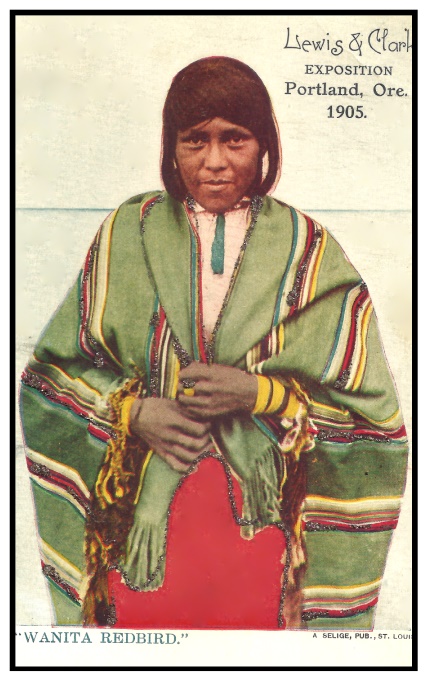 |
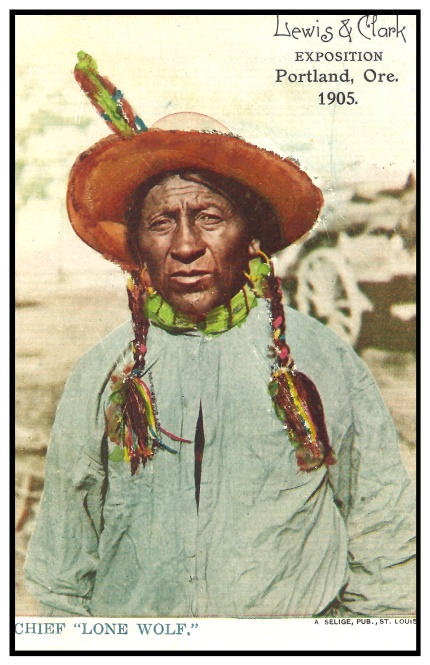 |
||
|
On April 2, 1806, William Clark wrote about a temporarily vacated 30 ft by 40 ft Chinookan house near what is now the Portland International Airport. The next day on April 3rd, on a visit to the village of Ne-cha-co-lee (translating to “Stand of Pines”), Clark recorded their exploration of a 226-foot long plank house near Blue Lake, near present-day Fairview. It consisted of seven apartments about 30 feet square. The house was covered with two layers of white cedar bark. Inhabiting a large area from Alaska to California, Chinookans were described as complex hunter-gatherers who came together to harvest the abundant salmon, game, plants and other resources in the area. They were also skilled craftspeople who created their own artistic style of clothing, and these styles were also represented in their basketry, tools, architecture and various items of wood, stone, bone and shell. Chinookans played a big part in the fur trade and they developed a Chinook Jargon known as the “hidden language of the Pacific Northwest,” that incorporated words from English, French, Nootkan and other tongues was widely accepted in trade circles, military forts, missions, reservations, households and multi-ethnic work places such as fishing boats, canneries, lumberyards, hop fields and mining camps. Native inhabitants were somewhat migratory, moving periodically throughout the region, to fish, hunt or pick berries when the season was right. The story is told of Old John, who lived from about 1800 to 1893, and was reportedly present at Ne-cha-co-lee, west of the mouth of the Sandy River near Blue Lake, when Lewis and Clark visited in 1806. In the last half of the century, Old John fished, tanned hides and labored on farms along the Columbia Slough from what is now Fairview to Parkrose. Old John lived in the woods, watched the homes and cared for the cattle when farmers were away. He was highly respected and protected by the white inhabitants at the time. Further to the south and away from the river, early settler accounts tell of other locations associated with Native Americans such as “Indian Rock” a natural amphitheater near present-day Foster Road and 100th Avenue in Lents. It was a long-established location for ceremonial activities until some of the young white settlers took potatoes and tomatoes as weapons and threw them at the dancing Indians. The Indians never danced there again. It is believed that Indian Rock was later quarried for road paving stone as well as channel liner for nearby Johnson Creek which had been an important fishing source utilized by Native Americans in the area. It is said the area was littered with arrowheads before it was intensely developed. If you have ever wondered why some of the major arterials in the area such as Foster Road, Sandy Boulevard, Cully Boulevard and parts of Powell Boulevard don’t fit the normal grid in traffic patterns, they all follow the routes of major Indian paths established prior to White settlement. It is believed that the Grotto, a natural rock formation near present-day Sandy Boulevard and 85th Avenue, served as a rock shelter. White settlement profoundly altered the way of life for Native American people. Native societies in the Northwest were decimated by diseases introduced by Europeans and Americans between the late 1700s and the 1850s. Their populations decreased by as much as 90 percent by the time of the civil war due to sickness and the appropriation of their land and resources, as well as forced relocation and assimilation policies. |
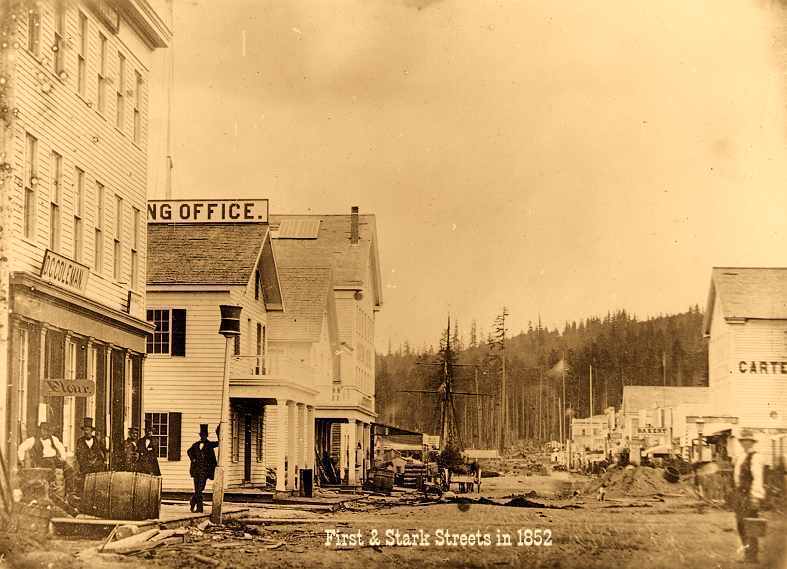 |
|||||||||
|
In 1843, Tennessee drifter, William Overton and Boston lawyer, Asa Lovejoy were floating down the Willamette River in a canoe when they came upon the beauty of the place we now call Portland. They beached their canoe where Chinook Indians had tied up their canoes in years past and made camp. They marveled at the beautiful mountains with the rich potential of the many trees. Overton didn’t have the quarter to file a land claim, so he sold half of his 640-acre site to Lovejoy for 25 cents. They began to clear the many trees, build roads and build the first buildings. Overton built a road to the westward hills and after a while, he decided to move on selling his half of the share to Francis Pettygrove. In 1845, James Terwilliger filed his claim to the south of Overton’s. Capt. John Couch filed his claim to the north. Portland got its name when Asa Lovejoy and Francis Pettygrove flipped a coin in 1845. Lovejoy was from Massachusetts and wanted to name the new settlement Boston. Pettygrove was from Maine and wanted to name it Portland. Pettygrove won the coin toss two out of three times and the rest as they say is history. Pettygrove and Lovejoy built a log store on their claim on the southeast corner of Front and Washington. Terwilliger built a blacksmith shop on his claim. Couch built a ferry dock on his claim for the canoes. In 1845, there were four streets and 16 blocks had been cleared and platted. Pettygrove hired George Bell to manage his store and Mrs. Bell was the first white woman in the community. Before the canoe ferries were started, settlers had to use a swimming horse to cross the river. David Lownsdale opened a tannery where Civic Stadium stands at 20th and Morrison Streets. John Waymire established the first sawmill in 1847. His team of Missouri oxen hitched to a lumber wagon served as Portland’s first transportation system. Lot Whitcomb operated a lumber mill at Milwaukie where he built a really fine river vessel which he named the “Lot Whitcomb”. It was launched on Christmas Day in 1850 by Captain J.C. Ainsworth. The first school was opened in 1847 by Dr. Ralph Wilcox. The first public school was opened in a public hall in 1849 by Rev. Horace Lyman. The first church, the West Union Baptist Church, opened in 1844 near Portland in the log cabin home of David Lenox. In 1848, a Methodist Church was established with Rev. J.H. White as minister. Portland’s first Post Office opened in 1849 in a small log cabin building at Front and Washington streets. Thomas Smith was appointed the first Postmaster on Nov. 8, 1849 By 1850, about 800 residents made their home in Portland, and the steam sawmill’s whistle could be heard at Fort Vancouver. There were 14 steamers docking at Portland’s wharves, and there was a log-cabin hotel and a newspaper, the Weekly Oregonian. Congress passed the Oregon Land Act, which entitled every man or woman to 320 acres. Portland was incorporated in 1851 and it has grown into the second largest city in the Northwest. People who settled in this region made their living from fish, lumber, wheat and cattle, and Portland became a major transportation center because of its proximity to Railroads and Rivers. In spite of streets that were deep mud in the winter and deep in dust in summer, Portland began to grow rapidly. Board walks were laid around them. The stumps were whitewashed to make them more visible. The first frame home was built by Captain Nathaniel Crosby from lumber brought around the Horn from the state of Maine. It was located at Front and Washington. A hospital was opened by Dr. Broy and Dr. Ralph Wilcox. Four boxes of Portland apples brought $500 in San Francisco. Had it not been for a woman’s intuition, the first Territorial Governor would have been Abraham Lincoln. Mrs. Lincoln refused to be separated from eastern cities by weeks of rugged wagon travel and rather than separate, Abe Lincoln turned them down. Joe Lane then became the first Territorial Governor. W.S. Ladd, who made his way to Portland in 1853 from Vermont, teamed up with Tilton to open the first bank north of Sacramento and the first bank west of Salt Lake City in 1858. By 1864, the population had risen to 6,068 and there were 1,982 children enrolled in Portland schools. Portland received its first telegraph message with news of the victory of Union troops at Richmond. Harvey Scott was Portland’s first librarian, operating a private enterprise with paid memberships in 1864. There were 1,500 books and a good collection of newspapers and periodicals. Other small communities began popping up: Linnton was platted by M.M. Carver and Peter Burnett. James John built a store in the newly platted St. Johns. The community of Goose Hollow was so named because most of the women raised geese while their husbands farmed or hunted gold. The town of East Portland was platted in 1861. |
|||||||||
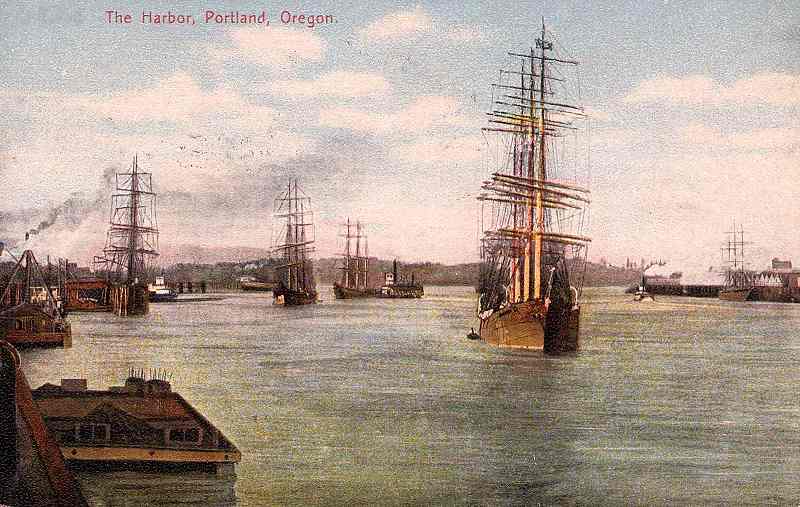 |
|||||||||
|
Portland began to grow and expand after the Civil War, building docks for shipping lumber, fish, wheat and produce to San Francisco and the rest of the world. Farmers were demanding better roads to haul their goods to Portland for shipment. Railroads history in Oregon began when Ben Holladay started building the Oregon & California Railroad in 1869. After running out of money in 1872, Henry Villard took control of the project and got as far as Ashland. In 1887, the line was finally opened to California, after the Southern Pacific took over construction. |
|||||||||
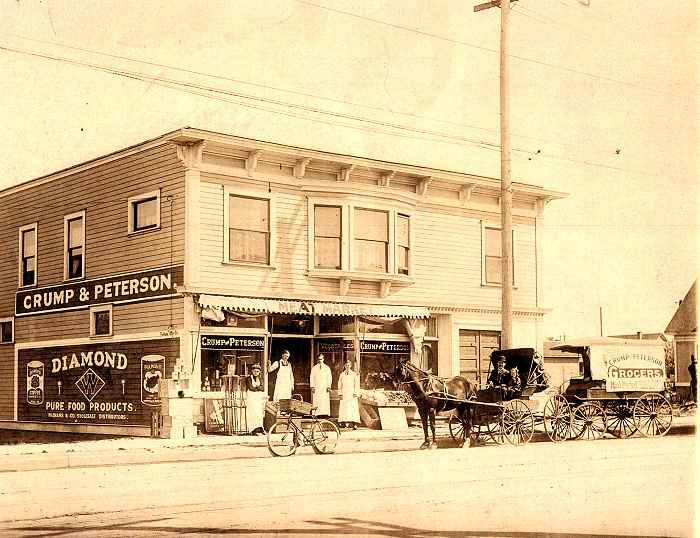 |
|||||||||
|
During the rainy months, the streets turned to mud and makeshift wooden sidewalks were built to get people out of the mud. |
|||||||||
|
|
In the early days, Portlanders had to walk, ride a horse or ride in a horse-drawn wagon to get around town. |
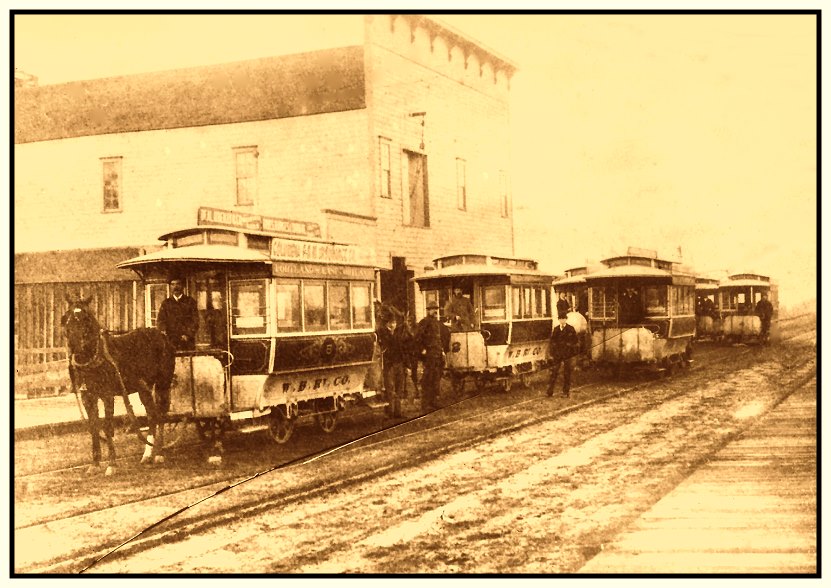 |
|
On Sept. 15, 1871, Portland Street Railway Company came into being. The resourceful Ben Holladay built Portland’s first horse-drawn streetcar and operated it along First Street. |
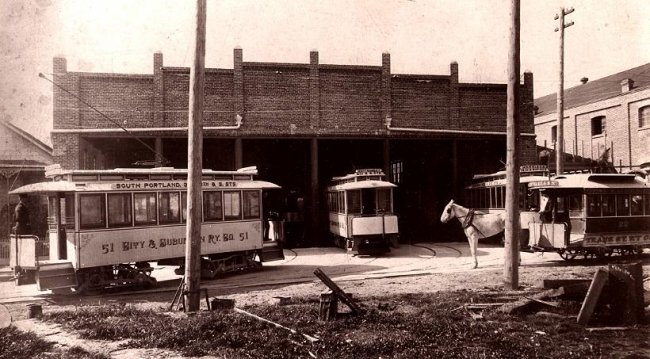 |
|
City & Suburban Car Barn at 23rd & Savior, June 20, 1892 the last day horses were used. |
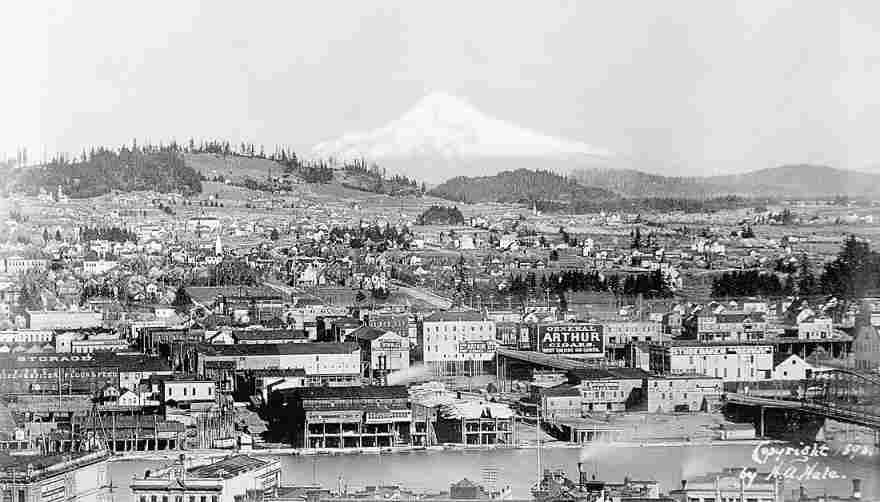 |
|
The town of East Portland was a growing concern by 1898. |
||||||
|
By the end of the 19th Century, Portland had 90,000 residents and it was the largest metropolis in the Northwest. Portland had the busiest port up the coast from San Francisco. The Alaska Gold Rush and the Railroads began to make Seattle boom. Portland’s leaders decided they needed to do something to promote growth so they decided to hold the World’s Fair here in 1905, when the Lewis & Clark Exposition took up residence along the waterfront in Northwest Portland. Three million people came to Portland’s Party and many of them decided to stay. Portland’s population doubled in the next five years. It is important to note that the Native people and their rich cultural heritage were not eradicated. According to the census taken in 2000, more than 37,000 Native Americans were living in Multnomah County. |
||||||
|
Last updated 04-04-18 |
||||||
|
copyright © 2019 PdxHistory.com |
||||||
| [Portland History] [Site Map] [Amusement Parks] [Early Portland] [Street Scenes] [Department Stores] [Streetcars] [Railroads] [Mt Hood] [Oregon Coast] [Post Card History] [Portland Hotels] [Portland Neighborhoods] [Getaways] [Contact Us] |